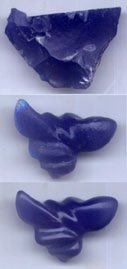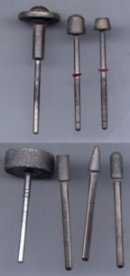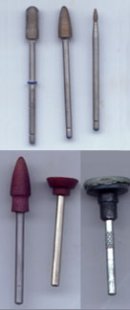|
|
|

Copyright
Carving in Blue Chalcedony
By Greg Fraser
| |

Top: blue chalcedony rough. Middle: carving after rough shaping. Bottom: finished carving.

Top: very coarse (80) carving burs. Bottom: coarse (120, 170) carving burs.

Top: fine (600) carving burs. Bottom: phenolic tool, flex disc.
|
Because I produce hundreds of carvings and freeform cabs yearly, I find it efficient to use a combination of hand and tumbler techniques. This works well with the whole quartz family - crystalline and micro-crystalline.
Eye protection and a dust mask are recommended for much of this work. For the hand carving, sanding and polishing, I use a flexshaft, working over a water container. Dipping very frequently clears the ground stone, keeps the dust down, and cools the stone. For carving points, I prefer high quality sintered diamond as the cheap plated ones don't last long on material as hard as chalcedonies.
- For this carving I selected a piece of blue chalcedony, cobbed clean. Since this was to be set in jewellery, I used a cabbing machine to flatten the bottom (80, then 220 grit diamond wheels). Holding the wet stone to a light, I examined for cracks and major inclusions. There were no major problems.
- Using a flexshaft and an 80 grit carving wheel, I cut away the small cracks at the edges, using the wheel at a 45 degree angle to the stone. With a wheel this rough, removal of material is quick, but chipping can be a problem, especially at the bottom edge. I liked the basic shape of the stone, and decided to extend some of the grooves started by the removal of the cracks, linking some, and turning them into graceful curves. Continuing with the rough wheel, I completed the basic shape.
- When satisfied with the basic shape, and an examination next to the light revealed no problems, I used 120-170 grit carving burs to refine the shape - cylinders with flat tops, used on edge to refine grooves, narrow cones to soften some grooves, and rounded bullets to smooth curved areas. A rolling motion with the bullet over rounded areas, working from more than one direction, will eliminate flat spots.
- I used a finer set of carving points to further refine the shape, 325 and 600 grit. After this, the piece looked great wet, and showed a very fine grittiness when dry.
- At this point, I switched to the tumbler. It is possible to do a piece entirely by hand, but I find the most difficult and time-consuming stage is the middle - the sanding steps preparing for prepolish. Using phenolic or wood points with diamond paste starting at 240, and progressing through 600 and 1200, has worked for me. However, I would rather let the tumbler do this while I start new carvings.
Since I'm not doing huge loads, I use a small-barrelled tumbler; it is vibratory but also induces rotary action of the material. The amount of time needed for each stage varies a lot depending on the tumbler, the hardness of material, the shapes and sizes of the material, the media and so on. I average about a week per stage, a little longer in the early stages. For media, I use a mixture of plastic pellets, ceramic spheres, ceramic cylinders with angled ends, and other oddly shaped pieces.
I start right back at the 60/90 grit stage (silicon carbide). This guarantees that given proper preparation and sufficient time, all little flat or uneven spots will be taken care of. If you're doing carvings with delicate, sharp edges, they might be dulled by this method.
- Clean the stones thoroughly before moving on. Stones with major problems can be culled out; stones with minor problems can be fixed with a little sandpaper (360 grit) or diamond paste on phenolic point in the flexshaft, then returned to the batch.
- I use successive stages of 110/220, 400, and 600 grit levels. It is possible to continue on to 1200 grit and final polish in the tumbler; however, stones tumbled well to the 600 level will finish by hand fairly easily.
- To handfinish, I return to the flexshaft, using flexible discs with built in grit. I use discs larger in diameter than the rubber backing pads in order to have more flexibility, easily getting into grooves and moving over the curves and ridges. Because the discs protrude over the edges of the pads, the adhesive they come with is insufficient, and I add lapidary disc cement.
I add a dab of 600 diamond paste to the 600 disc. One of the benefits is that the diamond paste imparts a bit of gloss to the stone, making it easier to spot any remaining surface imperfections.
- Next, I move through successive stages with flex discs of 1200, and 14,000 mesh, washing the stone and my hands with soap and water after each stage. I finish with 50,000 diamond paste (or cerium oxide)on a small felt pad. Using diamond paste on phenolic or wooden carving tools is an alternate to the use of flex pads.
Recommended Reading
For a broad discussion of carving styles and techniques, try Henry Hunt's book, "American Lapidary, Designing the Carved Gemstone", and for tips on tumbling, try Edward E. Smith's "How to Tumble Polish Rocks into Gems".
If you have questions, please contact me by e-mail, or visit my website: www.interlog.com/~chanfra/
Copyright ©1999 Greg Fraser
E-mail: chanfra@interlog.com
This article may not be copied, distributed or reprinted in any form without the author's permission. To contact the author, please use the e-mail address provided. If you are unable to contact the author, please contact the Canadian Rockhound. Authorized reprints must acknowledge the author, original source and the Canadian Rockhound, and include the website URL address of the Canadian Rockhound.
The preceding article was adapted from an article by Greg Fraser published in the February 1998 issue of Lapidary Journal. Reprinted in the Canadian Rockhound with permission from the author and Lapidary Journal.
More on Copyright

Document Number: CR993104
|




